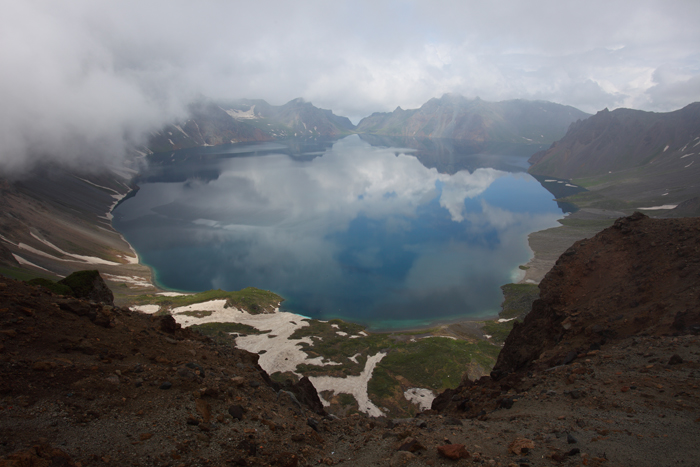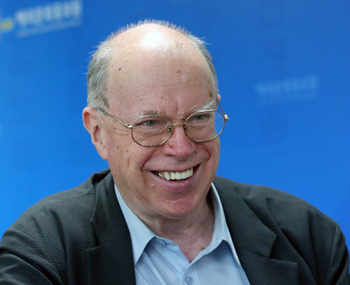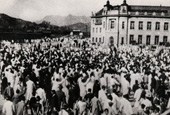From 1886 to 1887, Englishman Henry Evan Murchinson James of the Indian Civil Service used a two-year period of leave to travel to China. He and two younger British companions, the military officer Francis Younghusband and the China-based diplomat Harry English Fulford, decided to explore Manchuria, travelling as far as the “Changbai Mountains.” They depended largely on an account of the region found in volume two of Alexander Williamson's book “Journeys in North China, Manchuria, and Eastern Mongolia With Some Account of Corea” (1870).
Therein they could read: “The chief of the mountain ranges is that called the Shan-a-lin Mountains; their highest peaks lie on the south-east of Kirin, where they reach heights ranging from 10,000 to 12,000 feet, their summits being covered with perpetual snow.” Williamson in turn quotes a report written by T. T. Meadows, the British consul at Newchuang (Yingkou). “Manchuria Proper, as above defined, is a mountainous, well-watered tract, formerly altogether covered with forests, of which large portions still remain. The principal mountain range is the Chang-pih-shan, or Shan-a-lin, or Long White Mountains, which form the watershed between the Tumun, Liau-ho (Liao River) and Ya-In-kiang (Yalu River) on the south, and the Soongari (Sungari River) and Amoor (Amur River), with their chief right affluents, the Hurka (Mudan River) and Usuri (Wusuli River), on the north.”

Coming from China, the three British explorers began their Manchurian journey at Mukden, now called Shenyang. From there they thought to travel down to the Yalu River and follow it up to its source. They found that the rugged terrain made that impossible, but after many days of very difficult travel through swamps and bogs they began their ascent of Baekdusan Mountain from the northern side, as modern Korean tourists do.
At the time of their journey, native Chinese were settling Manchuria in large numbers. Koreans, too, were often encountered. Their local Chinese guide told them that the book was wrong, that there were no high, snow-covered peaks, only this, the Lao-pai Shan, or Old White Mountain.
“We came upon rich, open meadows, bright with flowers of every imaginable color, where sheets of blue iris, great scarlet tiger lilies, sweet-scented yellow day lilies, huge orange buttercups, and purple monkshood delighted the eye. Beyond were bits of park-like country, with groups of spruce and fir beautifully dotted about, the soil covered with short mossy grass and spangled with great masses of deep blue gentian, columbines of every shade of mauve or buff, orchids white and red, and many other flowers. One gem of a meadow was sprinkled with azaleas bearing small yellow flowers.”
It was now that they understood why the mountain was called “white”. “The whole steep side below was shining white, but not with snow, for there were only a few patches of it to be seen in clefts, but of wet, disintegrated pumice stone…At last we got to the top and looked over the edge, and lo! at the bottom of a crater on whose brink we were standing, about 350 feet below us, we saw a beautiful lake, its color of the deepest, most pellucid blue, and though the wind was howling above, its surface as still as Lake Leman, reflecting the crown of fantastic peaks with which the rugged top of the mountain was adorned. It was indeed a superb spectacle.”
James and Fulford tried to get down to the water but the slope was too steep. Meanwhile Younghusband climbed to the top of the highest peak. The weather, at the end of July, was extremely clear and he could see far in all directions. They could confirm that there were no higher mountains anywhere in sight.

It was only after their return home that they discovered a far older description of the lake at the top of the mountain. Jean-Baptiste Régis (1664-1738) was a learned French Jesuit who went to live in China in 1698. He was an expert cartographer, responsible for the first scientific maps of China and Korea. He explored Manchuria together with other French Jesuits.
Jean-Baptiste Du Halde (1674–1743) was a French Jesuit in Paris who collected and edited all the material that the French Jesuits in China sent him. His great work was the 4-volume “Description géographique, historique, chronologique, politique, et physique de l'empire de la Chine et de la Tartarie chinoise,” published in 1736. An English edition appeared in 1739 as “The General History of China.”
In the English edition, James discovered the following account of the “Pai Shan”. "The mountain from which the Sungari derives its source is likewise the most famous in Eastern Tartary. It lies much higher than the rest, and may be seen at a vast distance. One part of it is covered with wood, and consists only in a soft gravel which looks always white. Therefore it is not the snow that whitens it, as the Chinese imagine, for there never is any, at least in summer. On the top are five rocks, which look like so many broken pyramids exceeding high, and are always wet with the perpetual fogs and vapors that condense around them, and in the middle they enclose a deep lake, whence issues a fine fountain that forms the Sungari.”
There is no indication of who gave Régis this information. It is almost impossible that the Jesuits themselves made such a long and difficult journey. Some of the Manchus with whom they were closely associated must have climbed the mountain and recorded what they had seen.
Francis Younghusband was to become one of the most famous explorers of the period, and was later knighted for his work. In 1896, he published a book relating his exploits, of which the ascent of Baekdusan Mountain was only the start, as the title reveals: “The heart of a continent : a narrative of travels in Manchuria, across the Gobi Desert, through the Himalayas, the Pamirs, and Chitral, 1884-1894.”
Brother Anthony (An Sonjae)
President, RAS Korea
Discover Korea with the RAS
[The Royal Asiatic Society Korea Branch, founded in 1900, is an association of people, Koreans and non-Koreans alike, who wish to deepen their knowledge of Korean life, culture and history, and share that knowledge with others in English. http://www.raskb.com/ ]
Therein they could read: “The chief of the mountain ranges is that called the Shan-a-lin Mountains; their highest peaks lie on the south-east of Kirin, where they reach heights ranging from 10,000 to 12,000 feet, their summits being covered with perpetual snow.” Williamson in turn quotes a report written by T. T. Meadows, the British consul at Newchuang (Yingkou). “Manchuria Proper, as above defined, is a mountainous, well-watered tract, formerly altogether covered with forests, of which large portions still remain. The principal mountain range is the Chang-pih-shan, or Shan-a-lin, or Long White Mountains, which form the watershed between the Tumun, Liau-ho (Liao River) and Ya-In-kiang (Yalu River) on the south, and the Soongari (Sungari River) and Amoor (Amur River), with their chief right affluents, the Hurka (Mudan River) and Usuri (Wusuli River), on the north.”

A large crater lake, called Heaven Lake, is in the caldera atop Baekdusan Mountain (Photo: Yonhap News)
Coming from China, the three British explorers began their Manchurian journey at Mukden, now called Shenyang. From there they thought to travel down to the Yalu River and follow it up to its source. They found that the rugged terrain made that impossible, but after many days of very difficult travel through swamps and bogs they began their ascent of Baekdusan Mountain from the northern side, as modern Korean tourists do.
At the time of their journey, native Chinese were settling Manchuria in large numbers. Koreans, too, were often encountered. Their local Chinese guide told them that the book was wrong, that there were no high, snow-covered peaks, only this, the Lao-pai Shan, or Old White Mountain.
“We came upon rich, open meadows, bright with flowers of every imaginable color, where sheets of blue iris, great scarlet tiger lilies, sweet-scented yellow day lilies, huge orange buttercups, and purple monkshood delighted the eye. Beyond were bits of park-like country, with groups of spruce and fir beautifully dotted about, the soil covered with short mossy grass and spangled with great masses of deep blue gentian, columbines of every shade of mauve or buff, orchids white and red, and many other flowers. One gem of a meadow was sprinkled with azaleas bearing small yellow flowers.”
It was now that they understood why the mountain was called “white”. “The whole steep side below was shining white, but not with snow, for there were only a few patches of it to be seen in clefts, but of wet, disintegrated pumice stone…At last we got to the top and looked over the edge, and lo! at the bottom of a crater on whose brink we were standing, about 350 feet below us, we saw a beautiful lake, its color of the deepest, most pellucid blue, and though the wind was howling above, its surface as still as Lake Leman, reflecting the crown of fantastic peaks with which the rugged top of the mountain was adorned. It was indeed a superb spectacle.”
James and Fulford tried to get down to the water but the slope was too steep. Meanwhile Younghusband climbed to the top of the highest peak. The weather, at the end of July, was extremely clear and he could see far in all directions. They could confirm that there were no higher mountains anywhere in sight.

Brother Anthony
It was only after their return home that they discovered a far older description of the lake at the top of the mountain. Jean-Baptiste Régis (1664-1738) was a learned French Jesuit who went to live in China in 1698. He was an expert cartographer, responsible for the first scientific maps of China and Korea. He explored Manchuria together with other French Jesuits.
Jean-Baptiste Du Halde (1674–1743) was a French Jesuit in Paris who collected and edited all the material that the French Jesuits in China sent him. His great work was the 4-volume “Description géographique, historique, chronologique, politique, et physique de l'empire de la Chine et de la Tartarie chinoise,” published in 1736. An English edition appeared in 1739 as “The General History of China.”
In the English edition, James discovered the following account of the “Pai Shan”. "The mountain from which the Sungari derives its source is likewise the most famous in Eastern Tartary. It lies much higher than the rest, and may be seen at a vast distance. One part of it is covered with wood, and consists only in a soft gravel which looks always white. Therefore it is not the snow that whitens it, as the Chinese imagine, for there never is any, at least in summer. On the top are five rocks, which look like so many broken pyramids exceeding high, and are always wet with the perpetual fogs and vapors that condense around them, and in the middle they enclose a deep lake, whence issues a fine fountain that forms the Sungari.”
There is no indication of who gave Régis this information. It is almost impossible that the Jesuits themselves made such a long and difficult journey. Some of the Manchus with whom they were closely associated must have climbed the mountain and recorded what they had seen.
Francis Younghusband was to become one of the most famous explorers of the period, and was later knighted for his work. In 1896, he published a book relating his exploits, of which the ascent of Baekdusan Mountain was only the start, as the title reveals: “The heart of a continent : a narrative of travels in Manchuria, across the Gobi Desert, through the Himalayas, the Pamirs, and Chitral, 1884-1894.”
Brother Anthony (An Sonjae)
President, RAS Korea
Discover Korea with the RAS
[The Royal Asiatic Society Korea Branch, founded in 1900, is an association of people, Koreans and non-Koreans alike, who wish to deepen their knowledge of Korean life, culture and history, and share that knowledge with others in English. http://www.raskb.com/ ]

